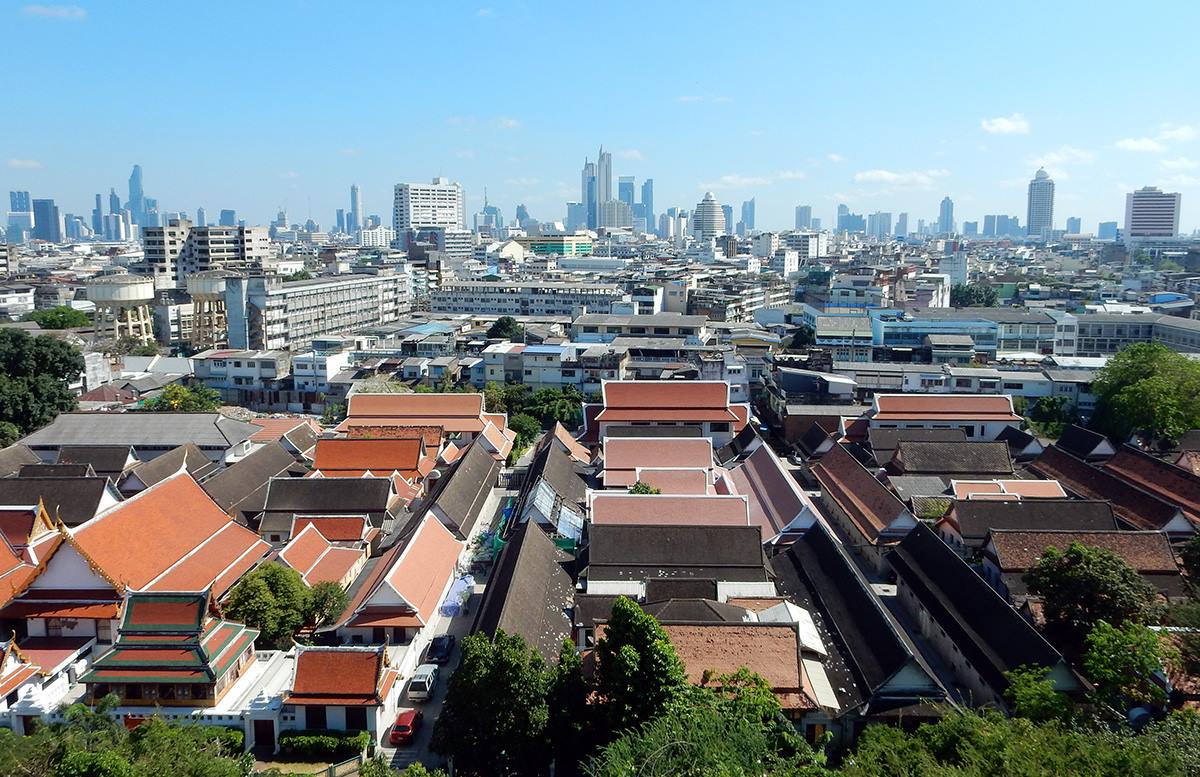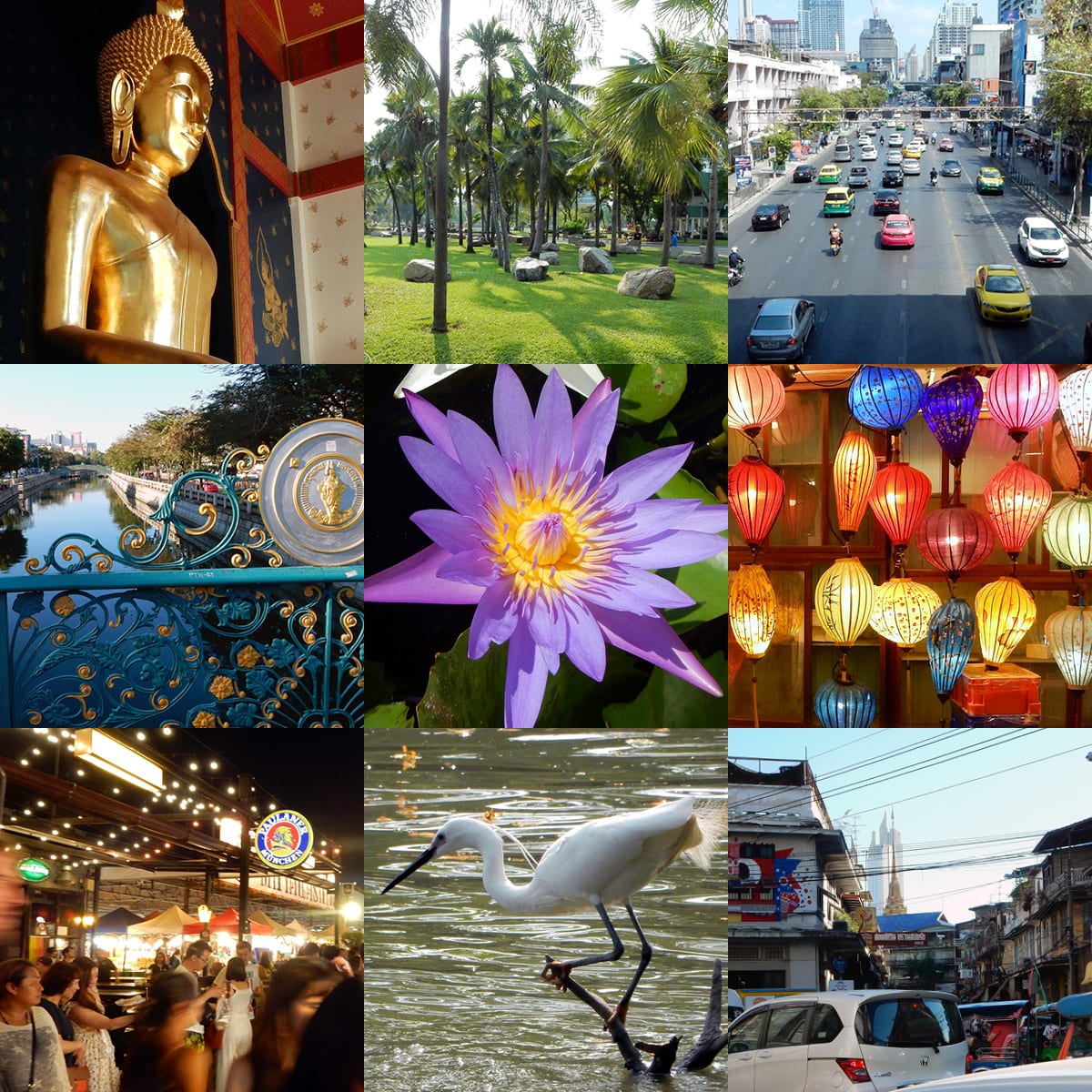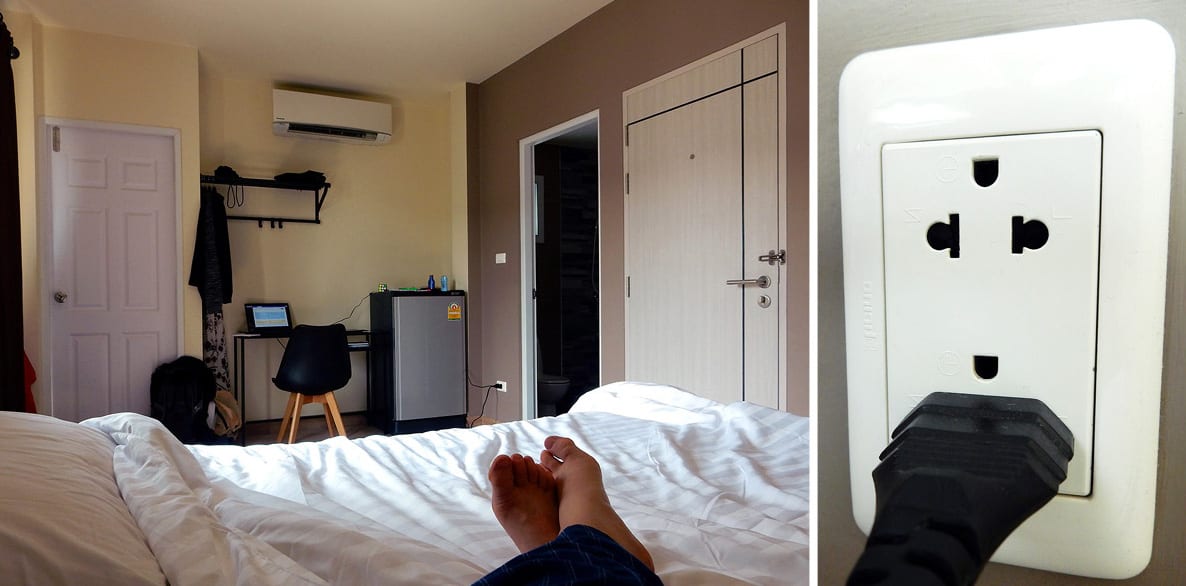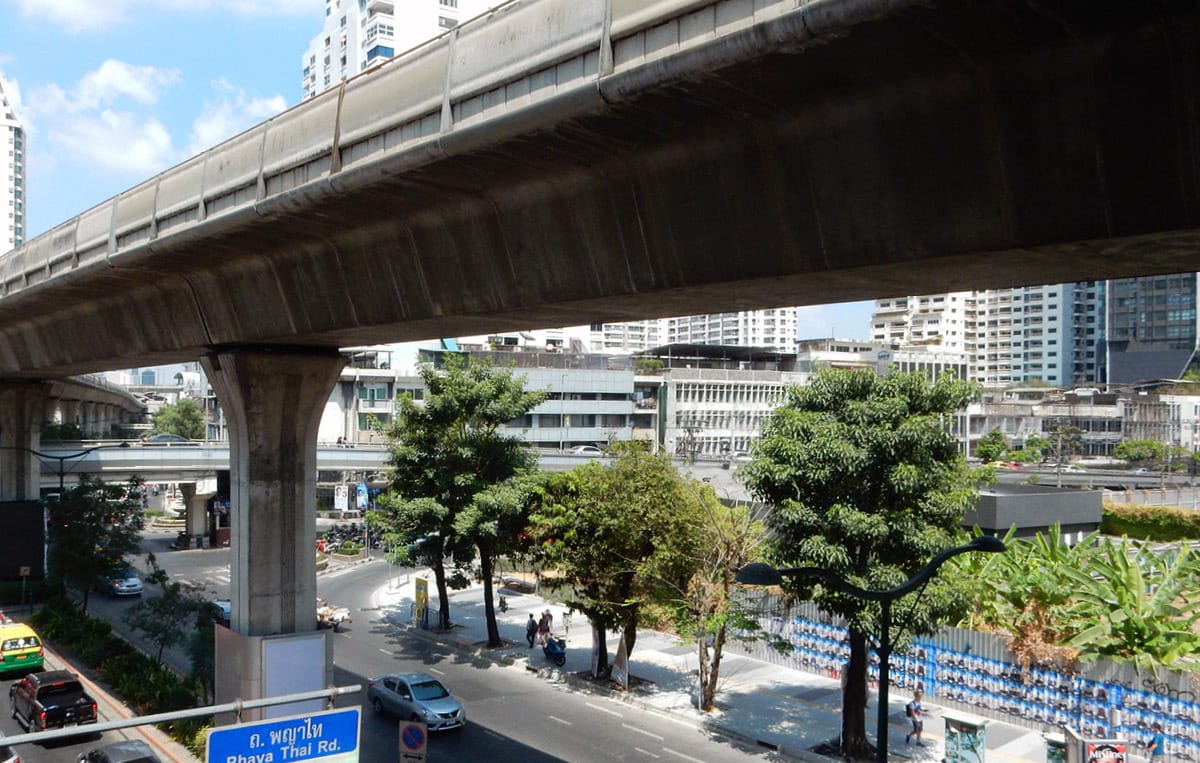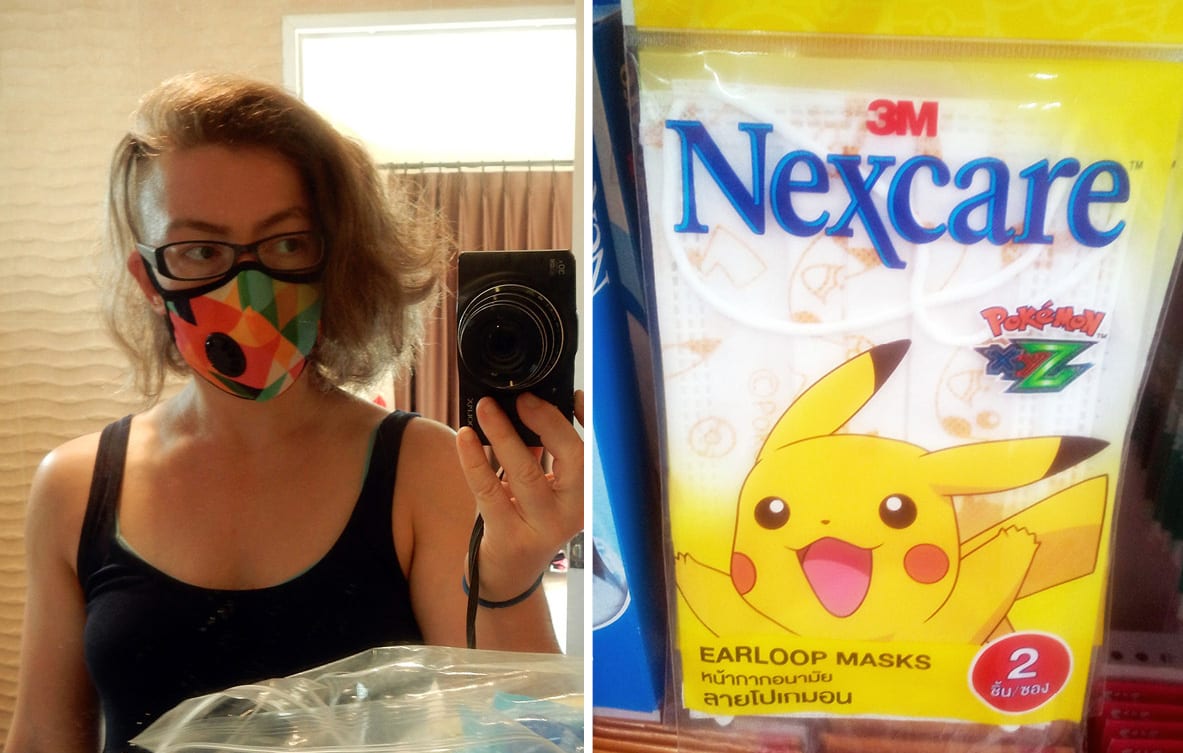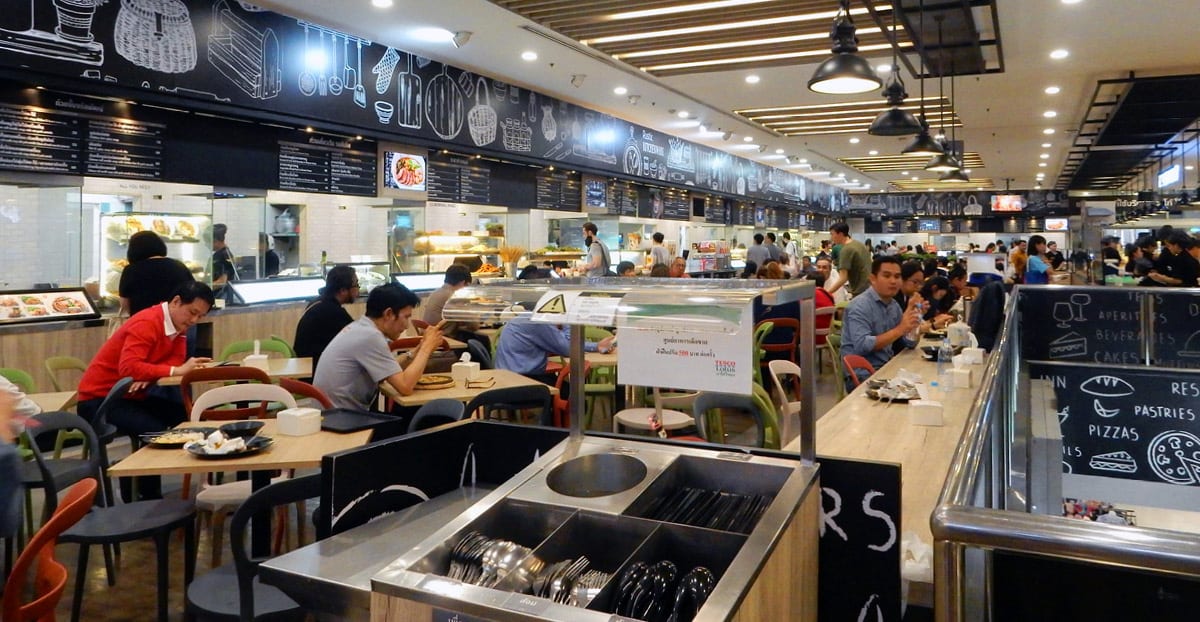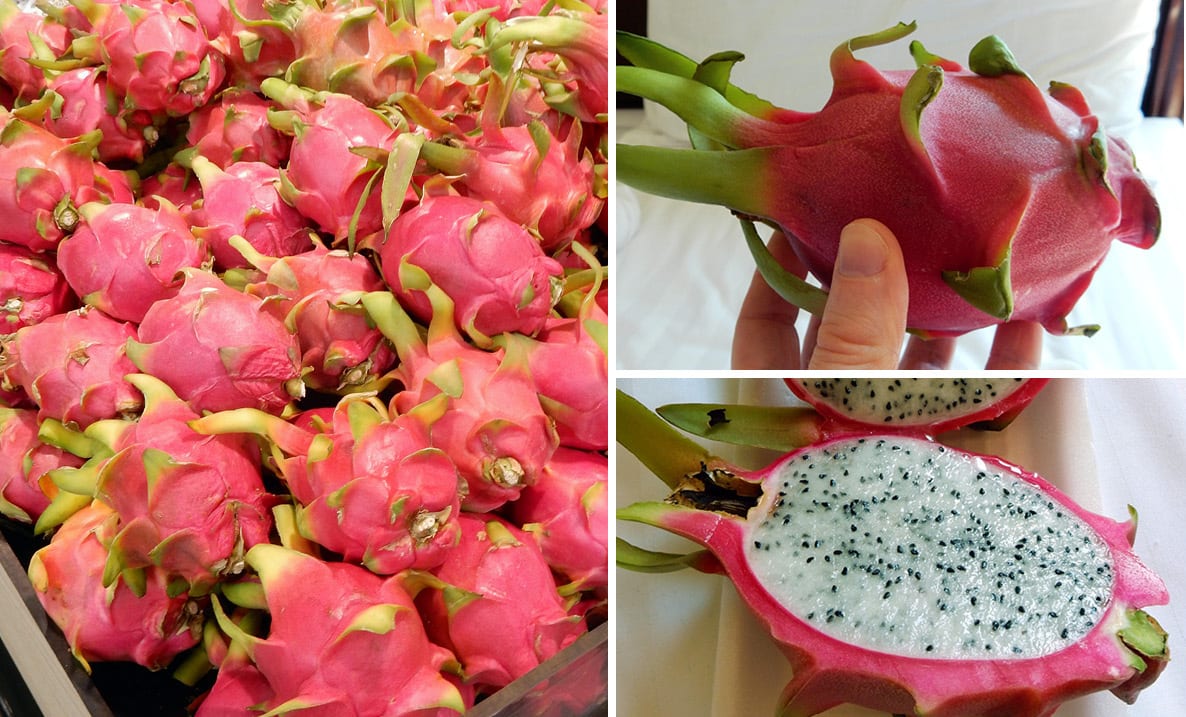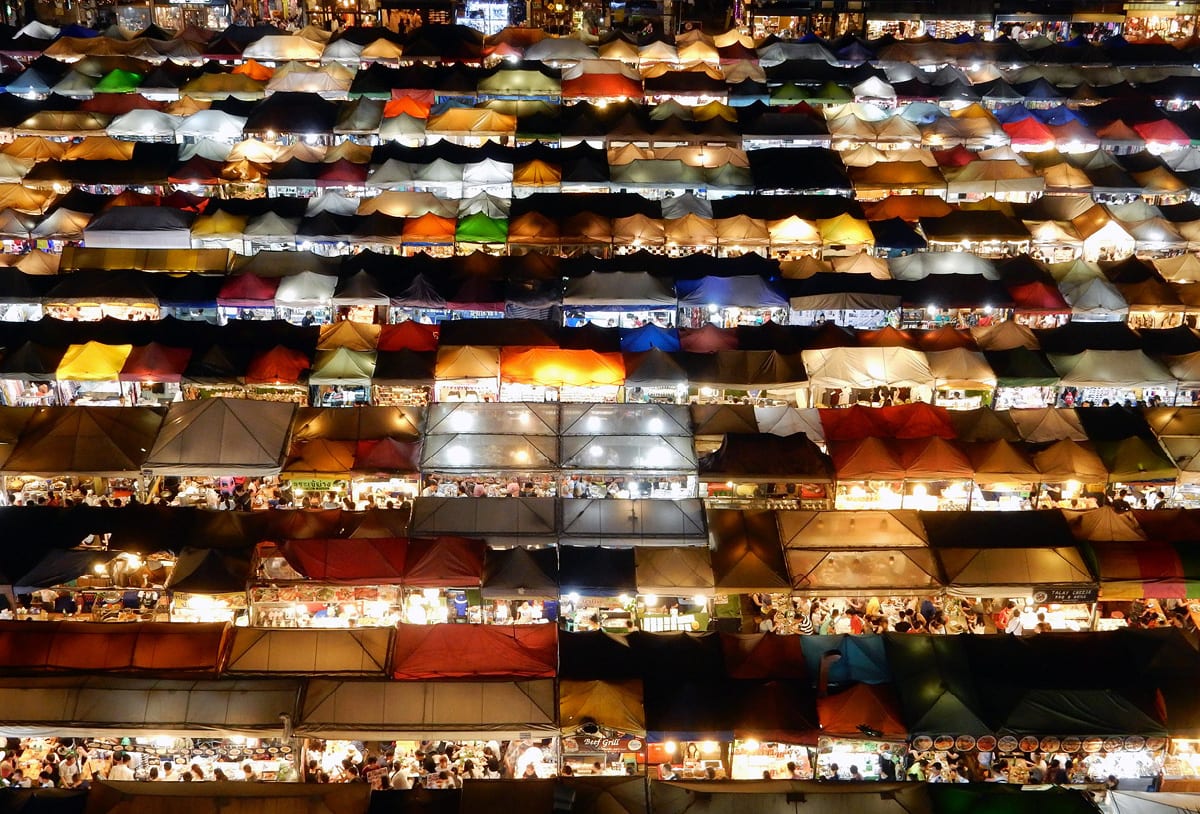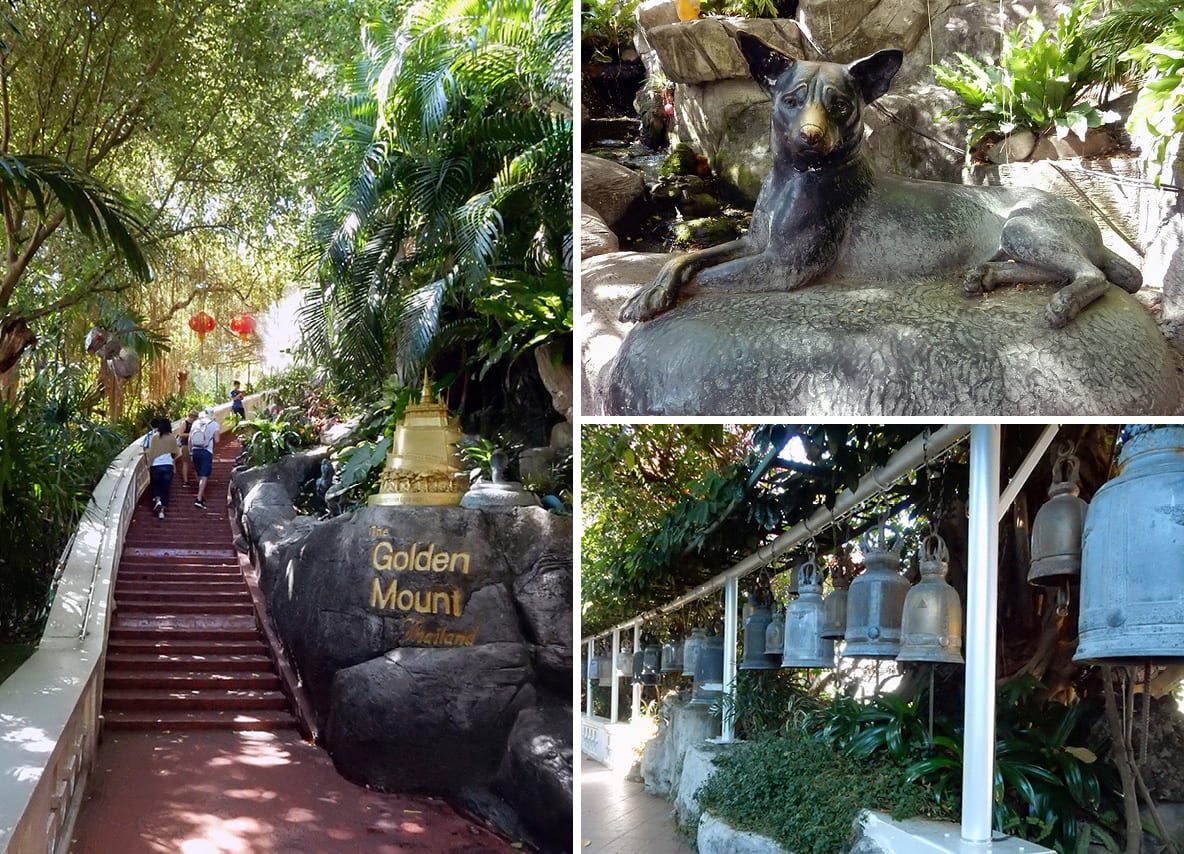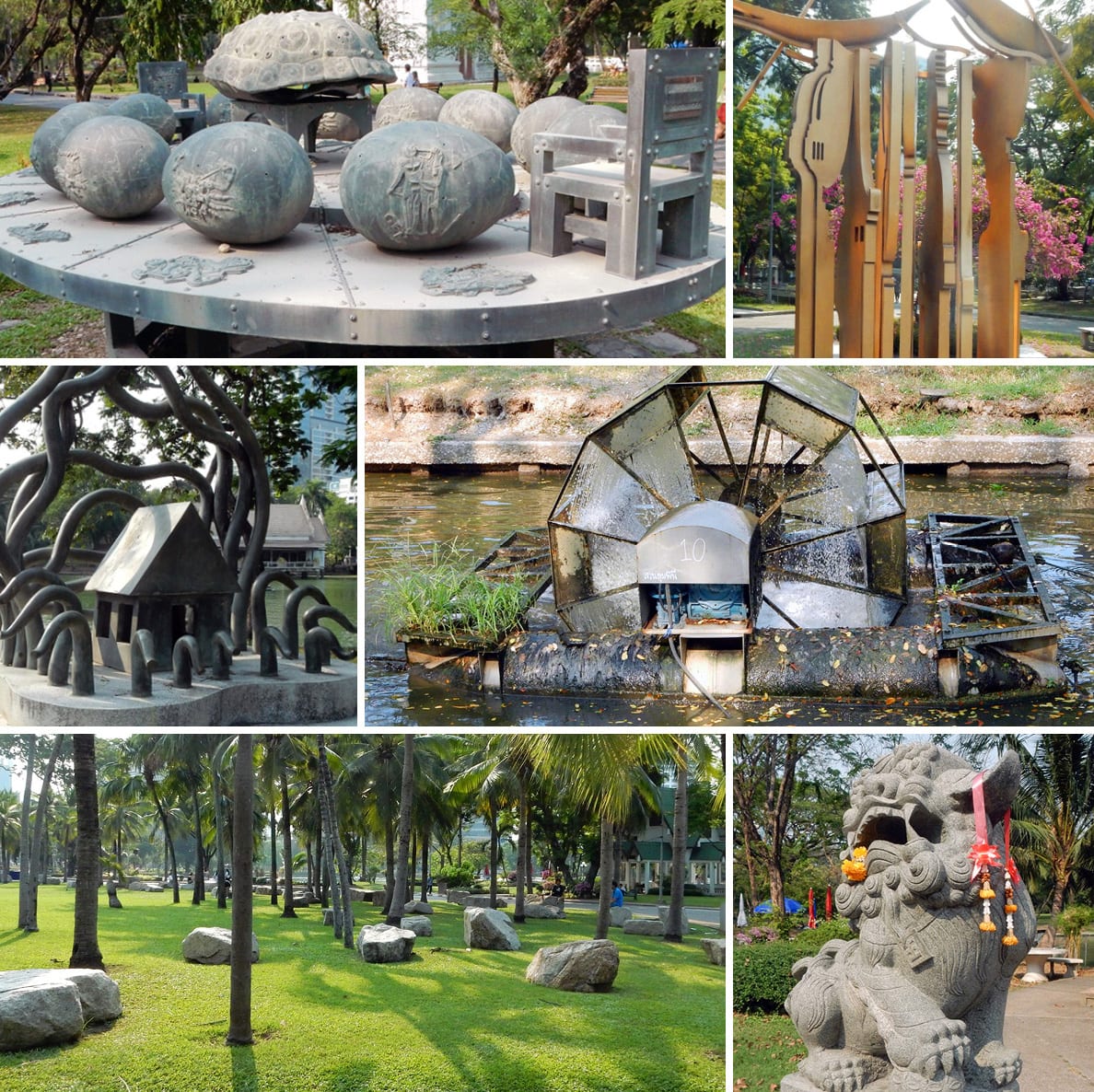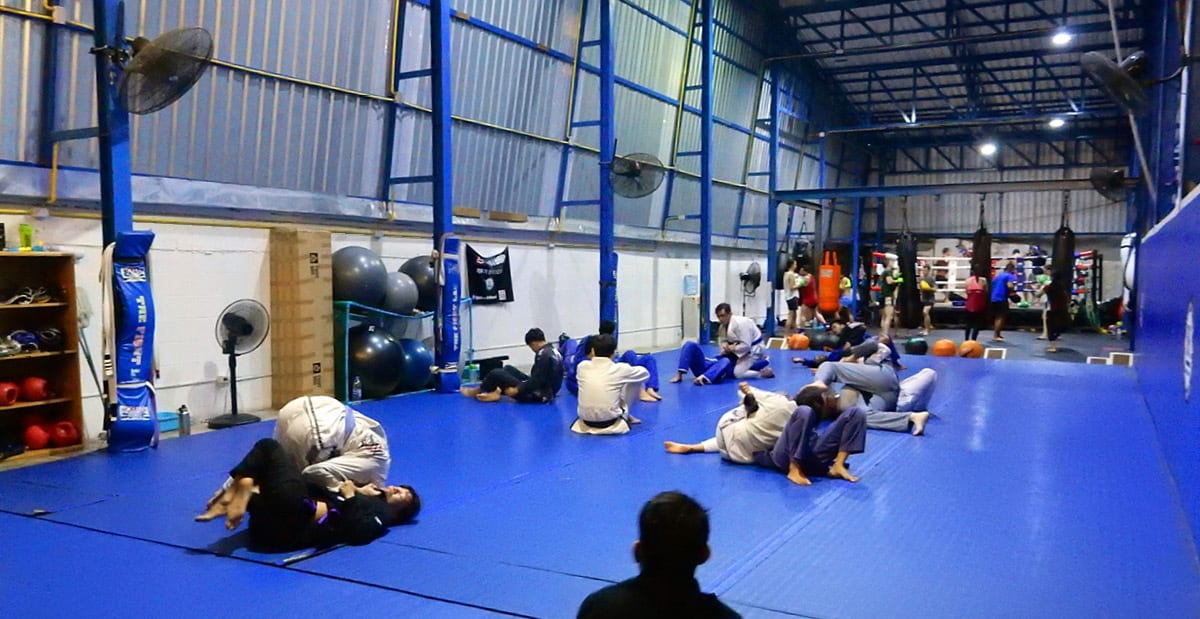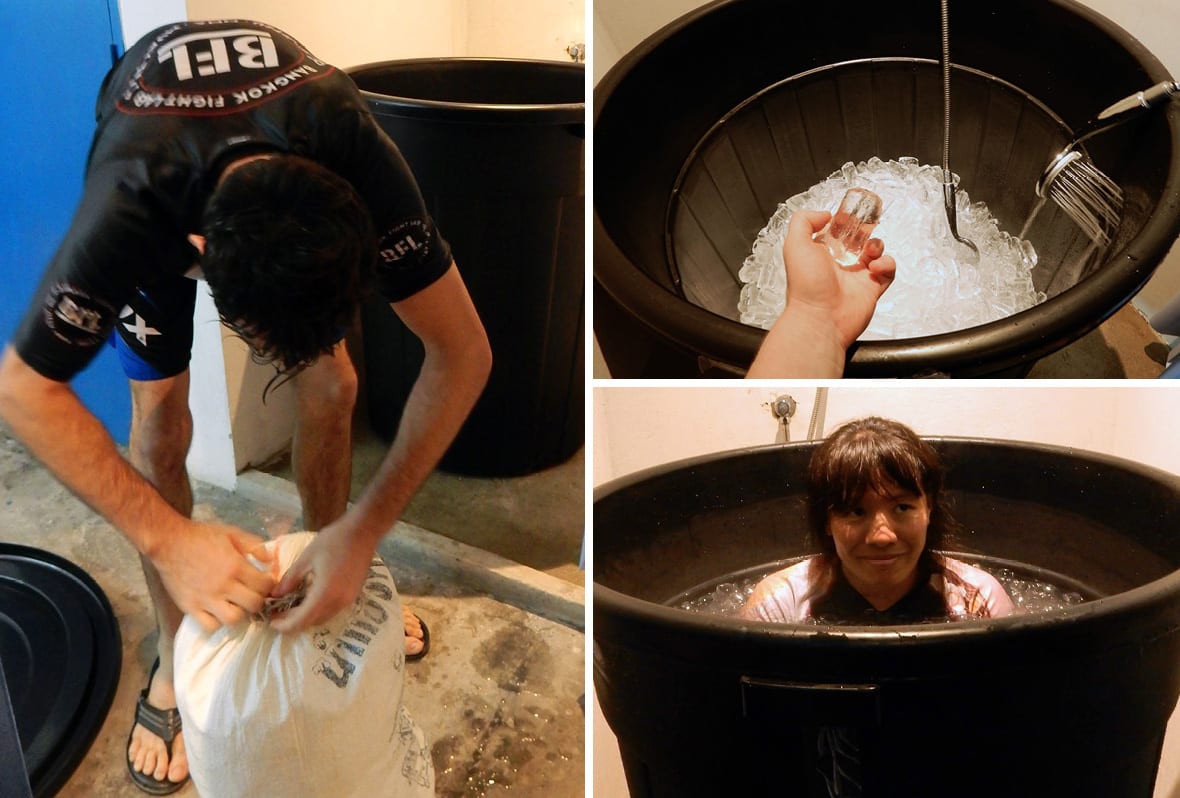Megacity Bangkok
Reasons to go: Amazing food, very affordable, night markets, modern big city convenience, tropical warm weather, beautiful Buddhist temples
Bangkok
Bangkok is immense – probably the biggest and most densely populated city I’ve ever been to! It has busy traffic with as many scooters as cars on the roads, constant background noise, and chaotic electrical wiring. It has buildings on a scale I’ve never before seen towering far above, a futuristic skytrain running stories above between the skyscrapers, and massive very modern shopping centers. It has tropical blue skies most days (at least in the dry season), constant heat, and high humidity. It has beautiful temples with ornate pointed roofs housing giant golden buddha statues, intricately patterned floors, and orange robed monks. It has exotic unknown fruits in the grocery stores, vendors selling drinks or cooking up fresh meals along the side of the street, and colorful bustling markets packed with people – I loved it all!
I was here for about 3 weeks in March.
The Visa Situation
Thailand grants free 30 day visas to Americans (and people of many other nationalities) upon arrival. Many people who visit Thailand fall in love with the country and end up wanting to stay longer. So, how to resolve this?
One option for this is applying in person at the embassy after you’ve arrived to Thailand on the 30 day visa asking for an extension. There’s a fee for this, and a limit on how many additional days you’re able to get.
Another option is to enroll in a Thai school, which grants you a longer student visa. Many people do this, then legitimately attend a Thai school to study Thai or a different topic from one of the English speaking schools. Some not-so-legitimate schools exist as well to help foreigners acquire student status permitting them to stay in Thailand longer.
Another option is teaching English or being employed by a Thai company. Yet another option (requiring a much greater investment) is to actually open a business in Thailand. There are numerous regulations applying to this, and the added requirement of employing a certain number of Thai people full-time.
One of the most common (though somewhat tedious) solutions is to simply leave the country then re-enter with a new 30 day visa, which is known as a visa-run. Obviously, it’s not ideal to have to repeat this process every month if staying long-term, especially if you live far from the border.
I’m sure many other options exist, these are just some of the more typical ways that foreigners are able to stay in Thailand for longer periods of times.
SIM Cards
You can purchase a SIM card upon arrival at the airport, there are many kiosks selling these with various plans depending on the length of stay and amount of data/minutes you’re looking for. I paid something like $25 for unlimited data for a month for mine, including a phone number and some talking minutes (which I didn’t need but were included anyways). Your passport is necessary for registration of the SIM card regardless of where you purchase it. The process of getting a SIM card was extremely quick and easy, taking less than 5 minutes to complete. I still don’t understand why America hasn’t gotten on board with pre-paid SIM cards, when literally the rest of the world uses these to get significantly cheaper cell service and data with no contracts!
Language
 The main language written and spoken in Thailand is Thai. The alphabet is non-Latinic and the language is tonal, meaning that the pitch of the word matters. The Thai language has 5 tones (middle, low, high, falling and rising) for different syllables of a word, which can change the meaning considerably. Fortunately, most signs in Bangkok have a smaller English translations underneath, and a many people speak at least a handful of words in English.
The main language written and spoken in Thailand is Thai. The alphabet is non-Latinic and the language is tonal, meaning that the pitch of the word matters. The Thai language has 5 tones (middle, low, high, falling and rising) for different syllables of a word, which can change the meaning considerably. Fortunately, most signs in Bangkok have a smaller English translations underneath, and a many people speak at least a handful of words in English.
People
People in Bangkok are so nice! In Thai culture, losing your temper and becoming visibly annoyed, impatient, angry or yelling is looked down on, and definitely won’t help you resolve a situation. This was explained to me as having something to do with pride and “losing face” – it’s an embarrassment and a disgrace for a person not to be able to maintain their composure, especially in public. If there’s a problem, Thai people address will the situation calmly and quietly.
Additionally, Thai people seem genuinely much more patient with everything. Things which would make American people anxious and irritated (like things moving slowly or rush hour traffic) just don’t seem to bother people here, they take it all in stride with a “well, that’s just how it is” attitude. Which is very refreshing and pleasant to be around!
Accommodations
Finding a place to stay in Bangkok was a little different than in previous cities, where I’d largely relied on AirBnB rentals. In Bangkok, however, AirBnB rentals are technically illegal, as is renting any part of a private home out for less than a month. Which isn’t to say you can’t find AirBnB rentals online (the laws regarding these don’t seem to be strongly enforced) – there are just less of them available.
Hoping to rent a tiny studio as opposed to a hotel room, I signed up to a couple expat and Bangkok city forums, but those wasn’t terribly helpful. The problem I ran into was length of contracts. Most were looking for tenants willing to sign a 6-12 month lease, whereas I was only looking for a 1 month.
Here again, Vara’s advice and knowledge of the city was immensely valuable! It was actually Vara who ended up finding the perfect home for me to rent – a tiny, very modern and clean studio with laundry machine on the ground floor, close access to the skytrain, with many restaurants and grocery stores within a 10 minute walk. It was part of a small house 3 stories high that seemed to have 3 apartments on each floor, though I think some of them were bigger models than mine. Best of all – it was literally right next to Bangkok Fight Lab!
The only downside was the noise, which I think is just a constant part of Bangkok wherever you go. Even with all the windows closed, the noise from vehicles driving by in the street was pretty constant and not quiet. In addition, I could feel the whole building tremble when larger vehicles passed by on the street outside a couple times a day. Oddly enough, this didn’t really bother or prevent me from sleeping at all. I enjoyed my stay here so much that I went ahead and made reservations to stay there for another month in July!
Outlets are both US and European style in one. Since I had various devices from my time spent in Belgium and Arizona with both US and European style plugs, this was really convenient!
Bum Gun
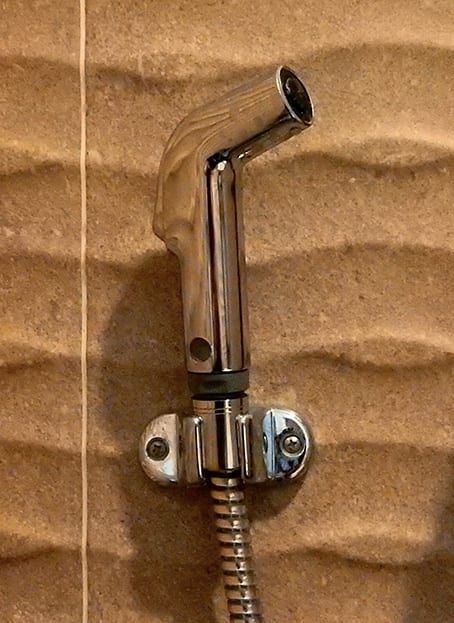 Toilets here are still the western-style (seated), but you cannot flush toilet paper. Instead, you dispose of it in a trash can off to the side. There’s also the addition of the “bum gun” which is a little spray hose off to the side for, well… exactly what it sounds like. As a westerner, this seems a little odd at first, but is actually really refreshing and seems much more clean when you get used to it! America and Europe should consider getting on board with these!
Toilets here are still the western-style (seated), but you cannot flush toilet paper. Instead, you dispose of it in a trash can off to the side. There’s also the addition of the “bum gun” which is a little spray hose off to the side for, well… exactly what it sounds like. As a westerner, this seems a little odd at first, but is actually really refreshing and seems much more clean when you get used to it! America and Europe should consider getting on board with these!
Wires
You’ll see some pretty crazy electrical wiring all throughout Bangkok! The story I heard is that the electric companies can’t keep track of the wires. Every time new electrical work is needed, rather than sort through the wires and figuring out how to tap into the existing connection – they just add more new wires.
Transportation
There are two main public transportation systems here which have a handful of lines throughout the city: the metro (MRT) which is underground, and the skytrain (BTS) which is a couple stories up, offering really great views of the buildings both below and towering above.
Most of the time, these won’t get you exactly where you need to go (because, Bangkok is HUGE!) but they will take you to the general area, and from there you can walk or take a taxi. Both metro and skytrain are very easy to use, very well organized, and very affordable. You can get a ticket from either a ticket machine (which has an English translation option) or a ticket counter. For the skytrain, you can either get a rechargeable card or just pay by trip (which cost about 0.75-$1.50 per trip, depending on the distance). The only slightly tricky part is that the trains get very full during rush hour traffic. I’m told you might sometimes actually have to wait a train or two for there to be room to board the train if the queues are long. I was always able to get a place, though they were packed pretty tightly with people on a couple rides. Fortunately, both metro and skytrain come very frequently, about every 10 minutes.
Besides the metro and skytrain lines, taxis are the main method of transportation for getting around town. They’re easy to find and very affordable. You can recognize a scooter taxis by the bright orange vest of the drivers. For price, drivers will either give you a quote in advance, or turn on the meter when you enter the vehicle. Another popular option is Grab, which is basically the Asian version of Uber. This is technically illegal in Thailand, but widely used regardless.
Overall, the streets in Bangkok are fairly regular, so it’s pretty easy to find your way around. The only slightly challenging part on occasion is finding the entrance to the underground metro.
Pollution
Bangkok was the first city I’ve traveled to where polluted air has been an issue. On the worst days, it wasn’t uncommon to see people wearing surgical-looking air masks, or to hear people coughing. People on scooters more frequently wear air masks as well regardless of how bad the pollution is that day.
Knowing pollution might be a problem in advanced, I’d purchased high-quality cloth air mask online before leaving US from Vlog Mask. Air masks come in a couple different ratings. You need one with N95 or N99 rating to filter out the most particles. It’s possible to purchase air masks in stores around town as well, though perhaps not of the best quality. Besides the rating, another important factor how well the edges fit around your face to prevent bad air from leaking in through the sides. Yet another factor to consider is the type of pollution. Air masks are more effective in filtering pollution caused by things that cause larger particles, like smoke from controlled burns. They’re less effective for things like exhaust fumes.
There’s a handful of different apps on your phone you can download to give you daily reports about the air quality – the one I used is called AirVisual. Some people are more sensitive to the pollution levels than others. General (short term) symptoms of pollution include coughing, burning eyes, sore throat, and difficulty breathing. Most days I wouldn’t have notice it at all, though I did get an itchy phlegmy throat and slightly stinging eyes on the worst days. Unfortunately, the air conditioning units pull air from outside and many places don’t have the best filtration systems, so you’re still breathing polluted air even when indoors.
Food
Food in Thailand is amazingly delicious! My studio didn’t include a stove (most rentals don’t) but with full plates of food costing only a couple dollars, eating out was very affordable here. I had a really fun time trying a huge variety of new meals with flavors I’d never tasted before! Food in Thailand consist largely of rice and noodles with various meats, veggies, and sauces pour over it, and light soup or small salads on the side. A lot of the food is fried, so perhaps isn’t particularly healthy. Despite this, it’s very uncommon to see overweight people in Thailand. Some meals included egg as well, either poached or as a thin omelette draped over a ball of rice. Pork, duck, or chicken is much more common than beef here.
Thai people love spicy food. I learned very quickly to avoid anything that looked like peppers or had an orange sauce, and to double check how spicy it was with the server before I order. Even meals that Thai people consider just “a little spicy” make my eyes water, nose run, and are borderline inedible to me!
I ate brunch most days at the food court in a giant shopping center near my studio. Here, I could get a full plate of food cooked fresh from one of many small restaurants for $1.75 – $2.50. Food courts here often function on a pre-paid card system. You get a card and load money into it, then pay with that for your meal instead of fiddling around with money at every shop, which is just much more efficient overall.
Fruit
Thailand grocery stores and street vendors offer a great variety of fruits I’ve never seen/tasted before – I wanted to try them all! Many of the fruits that are rare exotic imports in US (such as dragon fruit) are common and cheap here. On the other hand, many fruits American/European residents are accustomed to (such as apples and grapes) are imported and therefore much more expensive. New fruits I tried include longkongs (normal and mini), jackfruit, dragonfruit, mangostens, snake fruit and rose apples.
Ratchada Rot Fai Train Night Market
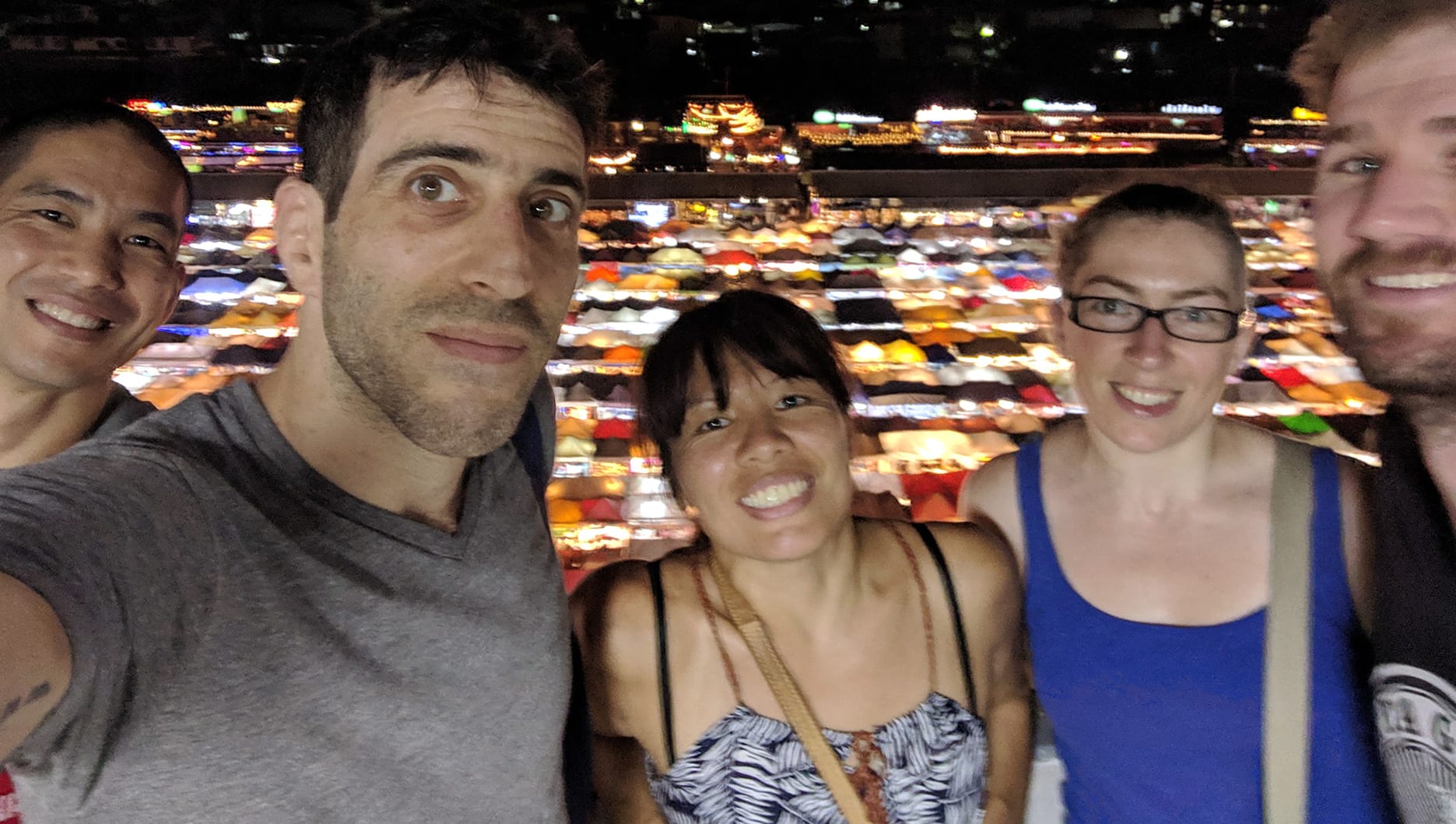 This is one of Bangkok’s many markets full of fresh-cooked vendor food, open every day. Vara led the evening, guiding myself and fellow globetrotters Alika, Scotty, and Josh up and down the very busy market aisles trying various snacks, giving us tips on what to try and explaining things along the way. There are stalls selling various non-food items here as well but again – the main attraction really is the food. All of it was amazingly delicious!
This is one of Bangkok’s many markets full of fresh-cooked vendor food, open every day. Vara led the evening, guiding myself and fellow globetrotters Alika, Scotty, and Josh up and down the very busy market aisles trying various snacks, giving us tips on what to try and explaining things along the way. There are stalls selling various non-food items here as well but again – the main attraction really is the food. All of it was amazingly delicious!
Vara somehow convinced all of us to try eating some grilled bugs that one of the vendors was selling. This is more of a tourist thing and not something regular people habitually eat though. We went with a kind of small grilled cricket, which seemed like a good “beginner” choice among the much larger water beetles and larvae looking things. Not saying I’d go out of my way to eat more but honestly – they really weren’t too bad!
Wat Saket (Golden Mount Temple)
This is one of Bangkok’s oldest temples, featuring a large temple as well as a giant golden chedi (a kind of stupa, or pointed bell-shaped decoration) at the top of a building which sits on top of a low hill that you can access by stairs. The temple at the bottom is free, though there’s a small fee to go up to the golden mount.
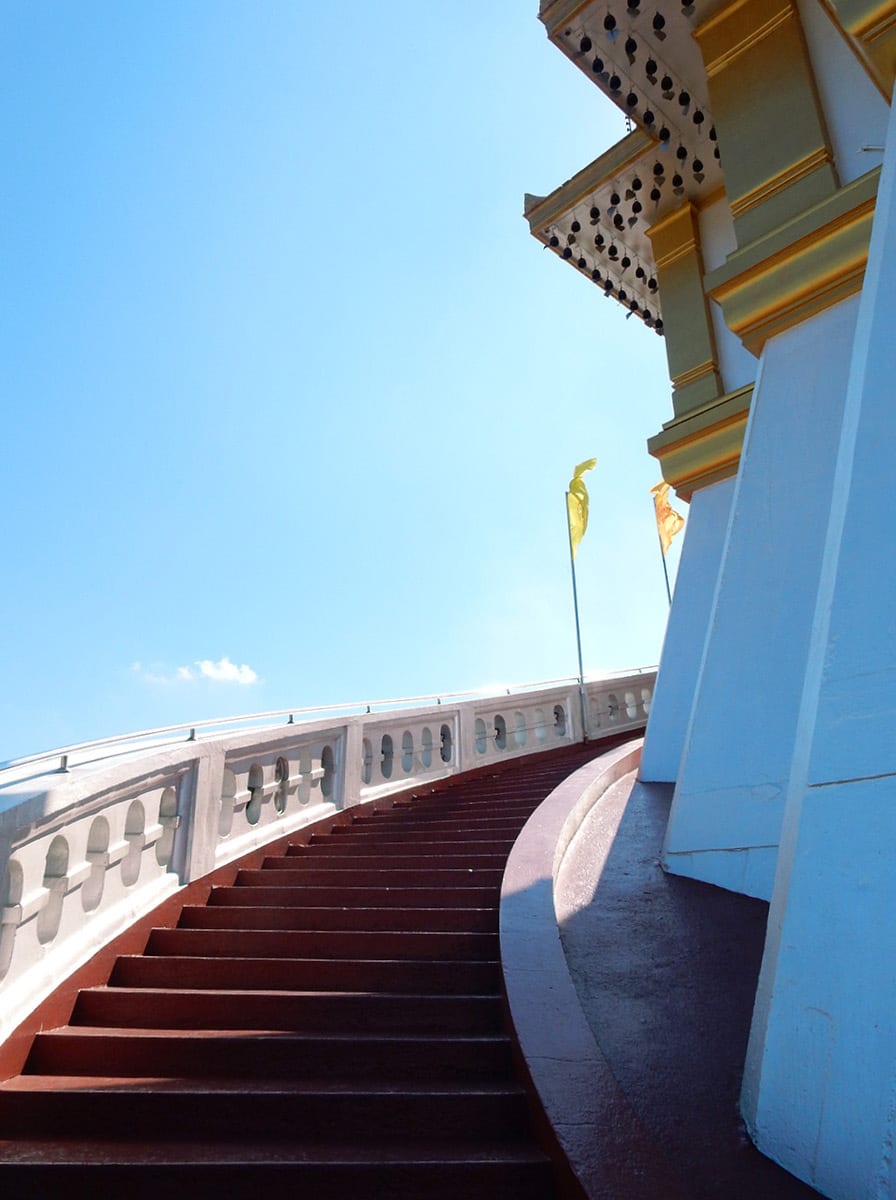 The walk up to the golden mount is 344 stairs long, but is a rather gentle climb with many decorative statues along the way (especially towards the base). There are also flat levels along the way, with lines of large bells (and even a couple giant gongs!) which you can ring for good luck. The path to the golden mount offers great views of the surrounding city all around!
The walk up to the golden mount is 344 stairs long, but is a rather gentle climb with many decorative statues along the way (especially towards the base). There are also flat levels along the way, with lines of large bells (and even a couple giant gongs!) which you can ring for good luck. The path to the golden mount offers great views of the surrounding city all around!
The temple at the base is very lovely as well, and consists of a large hallway lined with golden Buddhas, an open courtyard areas with heavily patterned tiled floor, and a large temple in the middle containing a giant Buddha statue.
A couple things to note: it’s important to dress appropriately when visiting any of the many Buddhist temples. This means shirts with sleeves (no tank tops), and dress/pants/shorts that extend at least below the knees. Some rooms require that you remove your shoes to enter, so keep an eye out for signs near the entrances or (if it’s a smaller temple without signs, or non-English signs) see what the local people are doing and follow suit. Out of respect, you should back away from the Buddha statues instead of turning your back to them. In addition, some statues or objects are meant for circumambulation – walking around them in veneration, meditation or respect. The direction here matters – these special objects should only be walked around in a clockwise direction. Also, avoid pointing the bottom of your feet at any of the religious objects or people (that’s super rude), and if you’re a woman absolutely do not touch the monks.
Lumpini Park
 This is a fairly large park in the middle of the city with many benches and seating areas, some artistic sculptures, a couple large ponds, little rivers crossed by bridges, an outdoor gym, a playground and the special feature of having big monitor lizards! I had the chance to see two of the lizards: a smaller one walking around near a tiny pond, and a much larger one swimming in the biggest pond.
This is a fairly large park in the middle of the city with many benches and seating areas, some artistic sculptures, a couple large ponds, little rivers crossed by bridges, an outdoor gym, a playground and the special feature of having big monitor lizards! I had the chance to see two of the lizards: a smaller one walking around near a tiny pond, and a much larger one swimming in the biggest pond.
I was here on a Sunday, it was pleasantly lively but not overly crowded, with many other people of all ages walking, jogging, and lounging around in the shade enjoying the park. Being in the middle of the city, it’s not isolated enough to drown out the background noise of cars, and you can still see the tops of tall buildings in the distance. But it was still a nice break from being surrounded by the dense buildings and busy streets of the city for a bit. I was very impressed by the large amount of people out jogging here, given that it was an exceptionally hot and humid day.
Bangkok Fight Lab is owned and operated by black belt Morgan Perkins, with a handful of other black belt instructors teaching classes as well, and is part of the Pedro Sauer Brazilian Jiu-Jitsu Association. It’s very conveniently located about 10 minutes away by foot from one of the On Nut skytrain stop, with classes given in English. Besides BJJ and nogi submission grappling, they offer classes in MMA, Muay thai, boxing, judo, general conditioning, and occasionally yoga. Vara teaches kids BJJ classes here a couple times a week as well.
Bangkok Fight Lab was a wonderful place to train – very technique oriented with an exceptionally friendly and welcoming group of people! I instantly felt at home here, it didn’t take long before I could recognize and knew a little about most of the regular students. This gym has a very international group including many expats as well as locals, with new visitors (many of them BJJ Globetrotters!) dropping in regularly. Vara continued to be my most regular training partner during my 3 weeks here, which did wonders for my technique overall but most notably vastly improved my triangles.
Training in the high heat and humidity was a real challenge, especially at first. Oddly, I felt most exhausted 10-15 minutes into the warm up, then somehow forgot about it for the rest of the class. It did become more bearable after a week, though I’m told it’s not something anyone ever truly completely acclimates to.
I meant to check out a few of the other gyms in the city to add to my training list… but have to admit I got a little lazy on this and didn’t end up making it happen. This was in part because I knew I’d be returning to Bangkok for another month later in the summer, so felt like I’d have plenty more time to do it later. It was also just hard to get motivated to take a longer commute to train much further away when I had such an awesome BJJ gym literally next door to my studio!
Bangkok Fight Lab: Nourish Cafe
On the upstairs level of Bangkok Fight Lab is vegan cafe called Nourish, owned by Tammi Willis (purple belt who also trains at Bangkok Fight Lab). Here you’ll find plenty of healthy meals, juices, energy bars, and protein shakes. If you need a break from rice and noodles, it offers some more western-style meal options as well, such as (veggie) burgers. They also have coconuts, which I now believe are the ultimate post-workout drink (natural electrolytes, refreshing, tastes great). As an added bonus, you can sit at the back counter looking down at classes training below!
Bangkok Fight Lab – Ice Bath
Every Saturday, Bangkok Fight Lab had a DIY ice bath session after training! This consisted of filling a giant round plastic bin with 4-5 immense bags of ice, filling it with water, then submerging one person at a time up to the shoulders with the goal of staying in for a full minute. Doing this is supposed to have all sorts of great health benefits that have something to do with capillaries and blood vessels constricting.
I hadn’t tried an ice bath before and the thought of getting into a giant bucket of ice water sounded like just about the worst idea ever, but I wasn’t about to turn down such a unique experience! The guys at the gym assured me that I wouldn’t have a heart attack, (probably) wouldn’t pass out, and that they’d rescue me if I did. Fortunately, Morgan didn’t give me a lot of time to think it over after I agreed to try it, otherwise I probably would have backed out!
The initial plunge felt about as bad as you’d expect from putting your entire body into bucket of ice water. My breathing and heart rate shot up, I found myself gasping uncontrollably for breath until Tammy reminded me to take deep breaths through the nose, which gradually brought it back under control a bit. Before I knew it, Morgan was saying the first 30 seconds was over, and shortly after that, the entire minute was done!
Felt amazing when it was over, so crisp and refreshing! I was actually really proud of myself for having made it through the entire minute. I continued to feel pretty great for the rest of the day, though whether or not that can actually be attributed to the ice bath is difficult to say. Anyhow, I enjoyed the experience so much I did it again the following weekend!

